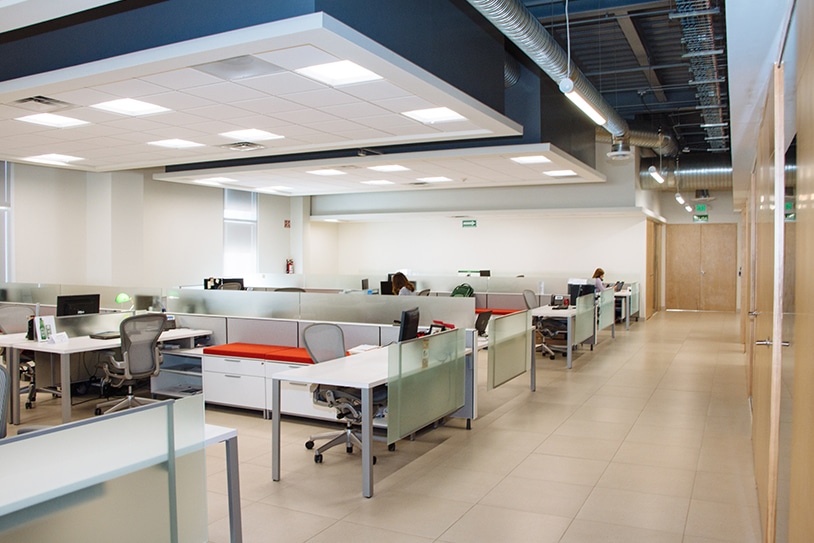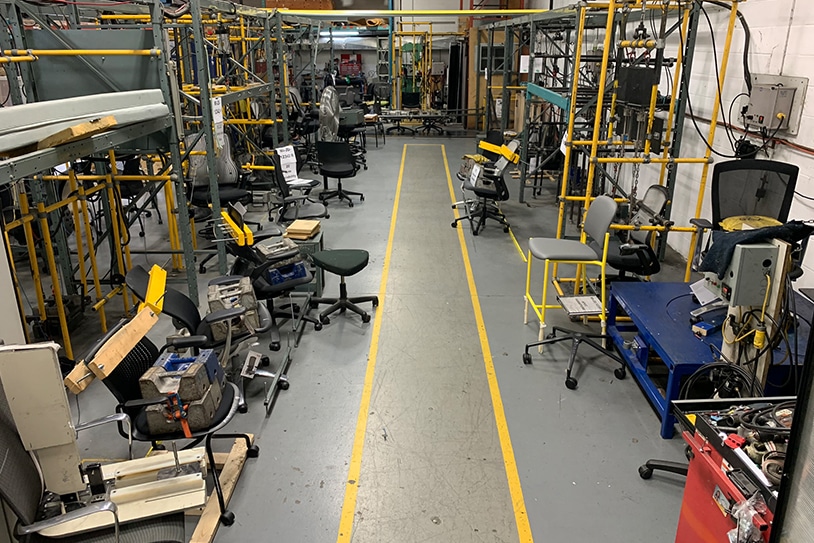
« Association canvas » BIFMA X5.5
BIFMA a récemment procédé à la révision de son standard ANSI/BIFMA X5.5 et a procédé à son « association canvas » basé sur la version publiée en février 2020. La version courante du standard date de 2014. Nous avons préparé pour vous une comparaison essai-par-essai pour les différentes sections du standard. Certaines des nouvelles exigences sont en fait des harmonisations avec la version courante de BIFMA X5.9
ANSI/BIFMA X5.5 vs « association canvas » comparaison essai-par-essai
| Section
# |
Section Title | Comparison | Conclusion |
| – | Title | Title is now “Desk/Table Products” instead of “Desk/Table Products – Tests” | No impact |
| 1 | Scope | Scope now includes retail spaces, restaurants, and cafeterias. | No retesting required:
All products tested are still valid |
| 2.6.2 | clear height | Clear space for units with a bottom reduced from 18 inches to 12 inches. Calculated load based on clear space will be reduced. | No retesting required:
18″ high units hold more weight than 12″ high units |
| 2.20 | folding leg table | Added definition for “folding leg tables” | No impact |
| 2.39 | Obstruction Response | Added definition for “Obstruction Response” | No impact |
| 2.50.4 | keyboard/laptop table | Depth limitation of 18 inch removed | May require retesting:
Units with depths >18 inch may need to be reclassified |
| 3.1.4 | Testing Considerations | Manufacturer’s accessories included in worst-case product condition | May require retesting:
If manufacturer’s accessories were not previously included in worst-case designs |
| 3.3.2 | Foot Clearance for Height Adjustable Tables | New requirement to have no less than 4.5 inches of clearance beneath a product suspended from a vertically user-adjustable surface. | May require retesting:
If clearance is <4.5 inch |
| 3.6 | Tolerances | Added requirement for calibration of devices used to measure test parameters | May require retesting:
If your lab’s calibration is not as stringent as new requirements |
| 3.10 | Temperature and Humidity Considerations | Added that sample should be stored in ambient conditions for at least 24 hours before testing. Conditions should be maintained between 15 to 27°C and 10-70% RH and if outside these limits they should be recorded | No retesting required:
New limitations are suggestions |
| Table 1 | Test Loads | Now all tables ≤45 inch in length require distributed loads | May require retesting:
Tables ≤45 inch in length will require retesting |
| Table 2 | Loading Guide | Loading Guide Added | No impact |
| 4 | Stability Tests | -Added that user-activated stability devices shall not be employed.
-Units are tested with doors closed unless otherwise specified or necessary to be opened for extendible elements. |
May require retesting:
If in the past tests were performed with stability devices employed and doors opened |
| 4.3 | Stability Under Vertical Load Tests | Test no longer applicable to units less than 17.7 inch in height | No retesting required:
Scope of applicable units reduced |
| 4.3.2 | Stability Under Vertical Load – Test Procedure | Additional stability test with a 75 lb static load to be performed. | Retest required:
Additional stability test to be performed |
| 5.2 | Concentrated functional load test | Test now applicable to fixed height tables >38 inch (half load) and adjustable tables that can be adjusted to >38 inch (set to 38 inch max). | May require retesting:
Tables >38 inch high will need to be retested |
| 5.4.3 | Concentrated Proof Load Test – Acceptance Level | Now allows a gradual loss of height for height adjustable surfaces | No retesting required:
New acceptance criteria are more forgiving |
| 5.5.3 | Distributed Proof Load Test – Acceptance Level | Now allows a gradual loss of height for height adjustable surfaces | No retesting required:
New acceptance criteria are more forgiving |
| 6.4 | Top Load Ease Cycle Test – Acceptance Level | Now allows a gradual loss of height for height adjustable surfaces | No retesting required:
New acceptance criteria are more forgiving |
| 8.3 | Leg Strength Test Alternate | New alternative method for performing leg strength test for units that could not be tested as per the traditional method (ex: scissor-type legs) | May require retesting:
If leg strength test was not previously performed due to limitations in the method. |
| 9 | Separation Tests for Tall Desk/Table Products | New limitation: test does not apply to privacy screens weighing less than 1 lb/ft2 and total weight exceeding 20 lbs. | No retesting required:
New limitations are more conservative |
| 9.3 | Separation Tests for Tall Desk/Table Products – Test Procedure | Additional limitations on the number of impacts for privacy screens <3 inch thick, components <24 inches wide, and component surfaces inset more than 12 in from support surface base-unit edge. | No retesting required:
New limitations are more conservative |
| 10 | Extendible Element Cycle Test | Tests no longer apply to extendible elements with functional load capacity of less than 15.4 lbs. | No retesting required:
New limitations are more conservative |
| 11.3 | Extendible Element Retention Impact and Durability (Out Stop) Tests – Test Procedure | Reset interval for compensation of ball-bearing cage creep now ≥500 cycles instead of ≥250 cycles. | May require retesting:
Extendible elements with ball bearing slides need to be retested if reset for creep |
| 14.3.3 | Force Test for Door Locks – Test Procedure | Force test now done loaded AND unloaded. | Retest required:
Additional force test now performed on locks |
| 15 | Work Surface Vertical Adjustment Test | Test no longer applicable to laptop tables | Retest required:
Method extensively revised |
| 15.2.1 | Work Surface Vertical Adjustment Test – Test Setup for Motor-Driven or Crank-Driven Surfaces | -Largest space-divider or privacy screen shall be attached to table during test.
-User adjustable obstruction response sensors now may be set at lowest sensitivity. -Functional load now applied to any storage elements. -New load and load distribution requirement. -Duty cycle requirement modified to 1 half-cycle on and then off for the time it takes to run 9 half-cycles. Was: 3 cycles on then off for the time it takes to run 15 cycles -Added: Motor-driven mechanisms that are software-controlled or have other control mechanisms to prevent damage during typical use shall not be disabled. Optional field installable sensors for added sensitivity shall not be installed during testing. |
|
| 15.2.2 | Work Surface Vertical Adjustment Test – Test Setup for Counterbalanced Surfaces | All applicable changes to 15.2.1 also apply. | |
| 15.3.1 | Work Surface Vertical Adjustment Test – Test Procedure for Motor-Driven, Crank-Driven, or Counterbalanced Surfaces | -Test procedure now applicable to counterbalanced surfaces as well (15.3.2 deleted).
-Test height intervals modified (no longer quartiles) -Total # of cycles increased from 4000 to 5010. -Frequency of recalibration routines changed from ≥1000 cycles to ≥500 cycles -If unit shuts down within any 500 cycle interval, it may be recalibrated/reset. |
|
| 15.4 | Work Surface Vertical Adjustment Test – Acceptance Level | Added requirement for motor driven units that if shutdowns occur more than 3 times within 500 cycles, this is considered a loss of serviceability. Double button pushes are not considered false interruptions; however no more than 25 double pushes shall be allowed in any given 500 cycle interval. | |
| 18.2 | Durability Test for Desks and Tables with Casters – Test Setup | -Now specified that rectangular units are to be cycled along their length.
-Cycling device may be lowered to prevent tipping. -Cycling rate changed to 10 +2/-6 cpm. -Tilt top tables now to be cycled half way stowed and half way open. |
May require retesting:
If unit was not cycled along its length and if tilt top tables not cycled as per new requirements |
| 19.2 | Pull Force Test – Test Setup | Permissible to support horizontal receding doors during the break-in period. | No retest required:
Additional instructions are suggestions, not requirements. |
| 23 | Monitor Arm Cycle Test – Cycle Test Rotation Movement at Arm-to-Monitor | Added rotation of monitor to arm joint (Figure 23e). | May require retesting:
If monitor to arm joint rotates and was not previously tested. |
| 25 | Unattached Table Top Retention Test | New test | May require retesting:
If unit had an unattached top |
| Appendix A | Impact Test Bag Construction | Sand removed as possible fill media. | May require retesting:
If your lab uses sand in their impact bags |
Laboratories Micom Inc. est un laboratoire d’essais indépendent accrédité par l’A2LA, l’ONGC, ISTA et de nombreuses autres organisations.
Avertissement
Toutes les informations et opinions contenues dans ce blog sont basées sur l’information et la compréhension que nous avons revues au moment de la publication. Cependant, malgré nos efforts, nous n’offrons aucune garantie quant à leur exactitude, la rigueur de notre enquête ou sa validité. L’auteur de ce blog n’est pas responsable des inexactitudes ou des pertes ou dommages qui pourraient résulter de l’utilisation des informations ou des données contenues dans ce document. Ce blog n’a pas été vérifié pour son exactitude par les associés de groupe de pairs avant la publication.




